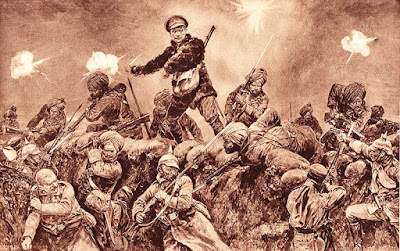 |
| Neuve Chapelle Memorial photo by Andrew Holmes |
 |
| Indian soldiers at Neuve Chapelle, 1915. (Official British Military painting published in "The Great War" Ed. H.W. Wilson, 1916) |
Gabbar Singh Negi was one of those who died in the battle; he was posthumously awarded the Victoria Cross for "his conspicuous acts of bravery and devotion to duty." His body was never found, but his name is recorded on the Neuve Chapelle Indian Memorial that lists the 4,742 Indian soldiers of the war who have no known grave.
H.W. Garrod wrote a poem on the battle (published in Worms and Epitaphs, 1919). It's brevity and directness need no comment: they shape the meaning of the poem.
Epitaph: Neuve Chapelle
Tell them at home, there's nothing here to hide.
We took our orders, asked no questions, died.
 |
| Neuve Chapelle Memorial CWGC photos |
In every way this epitaph sounds like a prequel to Rudyard Kipling's equally short poem 'Common Form'.
ReplyDeleteThe poem, which has this down-to-earth tone about it, 'just' states, and without any apparent feeling:
'If any question why we died,
tell them: because our fathers lied.'
Kipling, who had been every bit an imperialist and a close friend of the British Royal Family, is said to have written this because he never seemed to be able to get over the loss of his beloved son John 'nicknamed 'Jack'), during the Battle of Loos 1915.
All of this is described in the book-cum-movie 'My Boy Jack'.
Best, from Flanders
Chris
Thanks for another wonderful post. In her book Stand in the Trench, Achilles,Elizabeth Vandiver holds that Garrod's epitaph is modeled on that of Simonides for the dead at Thermopylae.
ReplyDeleteI've dipped in and out of Vandiver's book, but you've convinced me I need to read it in its entirety. Thanks for the fascinating information!
ReplyDeleteIt has been claimed that when accosted by a woman during the First World War asking why he was not with the soldiers fighting to defend civilisation, he replied: "Madam, I am the civilization they are fighting to defend."
ReplyDeleteA highly recommendable novel (probably the best there is) about the Indian contribution to the Great War alongside the British army is Across the Black Waters. It was written by Mulk Raj Anand and focuses on the fate of a sepoy fighting in the very north of France (region of Neuve Chapelle) and the southernmost part of West Flanders and the Ypres Salient, quite
ReplyDeletenear Roland Leighton's Plug Street.
This sounds wonderful -- I've added it to my Must Read list! Thanks, Chris.
ReplyDelete